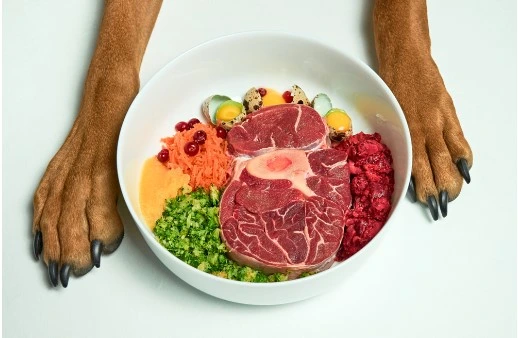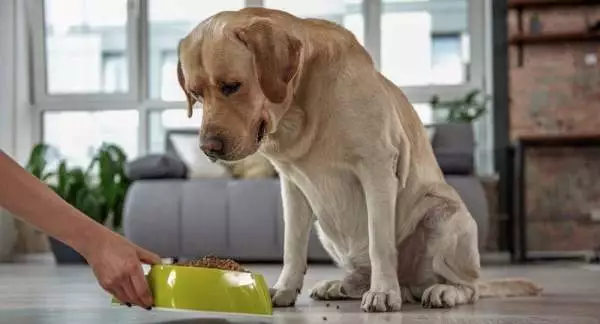
Constipation, which refers to the inability to pass a normal stool regularly, is a common problem in dogs. If your dog suffers from constipation, it will either force itself to defecate or not even try to do so.
With time, this may cause them to have a rock-hard stool, which can cause severe pain when defecating. Experiencing constipation can be uncomfortable for dogs and worrisome for pet parents.
So, it’s best to catch these signs early so you can take the necessary actions to provide relief immediately. Some symptoms of constipation in dogs include:
- Loss of appetite
- Vomiting
- Small amounts of feces that are watery
- Weight loss
You may also notice your dog frequently squatting or circling excessively. There can be several factors contributing to your dog’s constipation. The most common causes include a lack of exercise and a poor diet.
If your dog is a couch potato that only wants to spend its day curled up on the couch, he/she is more prone to suffer from constipation.
In such a case, you need to ensure your dog starts to exercise regularly and works towards a healthier lifestyle. Try taking a trip to a dog park and playing a good game of fetch.
Moreover, you need to ensure your dog receives a diet high in fiber and other vitamins and minerals that match the breed’s lifestyle.
Knowing how much and what to feed your dog based on its size, activity, and gender can go a long way in ensuring your dog receives an excellent diet.
For example, if you own a Goldendoodle, you must feed it a diet that consists of the best food for a Goldendoodle. Ideally, dogs should eat only 10-20% of the fruit and vegetables in their entire diet. You can also feed your dog cooked meat such as chicken, turkey, lean ground beef, and chuck steak or roast.
These are animal-based proteins that help your dog grow strong and stay fit. However, never feed your dog raw or undercooked meat. Always ensure it’s well-cooked. Avoid seasonings, onions, and garlic as they can be harmful to dogs.
If you’re still unsure about what food to feed your dog, you can consider checking out Kindful Dog Food – a pet food developed by pet nutrition experts that is high in all necessary minerals, vitamins, and fiber.
Other facts contributing to constipation in dogs include:
- Blocked anal sacs
- Excessive self-grooming leads to large amounts of hair collecting in stool
- Medication side effects
- An orthopedic issue that causes your dog pain when positioning himself to defecate
- An enlarged prostate gland
- Sudden change in diet or new food
- Indigested pieces of toys or other non-edible items such as dirt, plants in the intestinal tract
- Pelvis trauma
Treatment For Constipation In Dogs
Every dog is likely to suffer from constipation at some point in its life. Luckily, constipation can be treated easily as it’s a common affair in dogs. However, how quickly the problem is resolved usually depends on the cause.
Here are some remedies and constipation treatments we recommend trying out if your dog is prone to constipation:
Home Remedies –
Since poor nutrition and an inactive lifestyle are commonly linked with constipation, home remedies can help. A simple change in your dog’s lifestyle can quickly resolve constipation and provide the pain relief it may be causing.
- Regular Exercise: As mentioned above, regular exercise can help resolve constipation. It will also help your dog maintain a balanced weight, preventing obesity and keeping its joints healthy and strong. Exercising can also help your dog keep its mind sharp. Moreover, a long walk in the evening can help your four-legged BFF move its bowels. You can include running, long walks, and activities of fetch and chase in your dog’s daily exercise routine.
- Try Canned Food: Soft dog food with a high content of moisture can help keep your dog’s digestive system in check, and help regulate softer stool.
- Keep Your Dog Hydrated: Your dog should always have access to clean and fresh water. Being hydrated can also help regulate bowel movements.
Get Veterinarian Support –
If changes in your dog’s lifestyle and diet do not provide relief, it’s time to book a visit with your vet. Make sure you know your dog’s medical history well and can trust the vet.
The vet will likely inquire about your dog’s last normal bowel movement, stool color, symptoms, injury, and whether or not there were any recent changes in his/her diet or lifestyle.
If your dog has chronic or persistent constipation, the vet may recommend certain medications or other treatments. These include:
- A low-residue diet
- Laxative to induce stool
- Manual removal if the colon is affected
- Enzyme-blocking medications
- Surgery
- Nerve-stimulating medications
- Fiber supplements
- Enemas
A low-residue diet is often a preferable solution for persistent constipation. It leads to your dog digesting more nutrients and passing on less waste to the colon. Enemas, however, can be uncomfortable for your dog.
Most dogs do not tolerate the procedure well and it certainly should not be forced upon any dog. Moreover, enema solutions can also lead to injury if not done correctly. If the need occurs, make sure only an experienced vet performs the procedure.
Additionally, do not give any laxatives to your dog unless a vet recommends so. Long-term use of these medications can be unsafe as they can lead to dehydration.
Untreated Constipation – Complications
Like every other illness, constipation should never be ignored and left untreated. Untreated constipation can eventually develop into obstipation. An obstipation is a severe form of constipation that is often linked to an irreversible medical condition.
This occurs when the waste in your dog’s colon becomes extremely dry and hard and can not move. When the colon becomes filled with stool and your dog can not pass it, this can lead to a condition called megacolon, leading to your dog’s colon becoming extremely large.
Your dog may become severely bloated, and lethargic, forcing himself to defecate, and also causing vomiting. Getting your dog’s stool removed manually can also prove to be costly. Moreover, the process involves anesthesia which is another risk to your dog’s health.
READ THIS ALSO:-
- 10 Best Foods to Feed Your Dog When He’s Sick
- Barf Diet For Dogs: Here Is The Complete Guide 2022
- Can Dogs Eat Sour Cream? Is Sour Cream Safe For Dogs?
- Can a dog eat bread? Everything you need to know
Conclusion –
Friends, I hope You must have liked the blog “ Use Diet, And Exercise To Prevent Canine Constipation“
If you have any feedback, then definitely tell us by going to Contact Us, you can email me or follow me on social media Will see you soon with a new blog, till then stay tuned to my blog “Thanks


